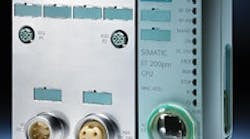Bulky enclosures took up valuable space and increased costs. Repositioning or adding new machinery/controls was time and cost-intensive. Reprogramming existing controllers to accommodate additional control could be a real headache.
Siemens Energy & Automation reports it has a first in the effort to eliminate these problems. The company has introduced cabinet-free distributed intelligence over Ethernet at the field level with its new Simatic ET 200pro CPU.
"The ET 200pro CPU offers the same basic capacity and functionality as our most popular mid-range programmable controller, S7-300/CPU315, but in an IP65/67 form factor allowing cabinet-free mounted distributed control," says Jim Wilmot, Siemens PLC product marketing manager. "The big benefit of the ET 200pro CPU is that it shifts distributed intelligence to the field, saving the cost and space of a control cabinet, and increasing flexibility in regards to mounting location/environment," says Wilmot. "Previously, IP65/67 remote I/O was mounted directly on the machine, and control had to be done using a separate controller mounted in a cabinet away from the machine. Now the CPU is machine mountable in the field along with the I/O. There no longer is a need to buy a separate CPU housed in a cabinet to do the control. The CPU itself now is part of the distributed system. For applications in which the ET 200pro can be the main controller, it creates a much cleaner design using a common form factor of components and eliminating spare parts."
Wilmot anticipates ET 200pro CPU will be especially popular in automotive and food and beverage applications, as well as in conveying operations where mounting flexibility is critical. The controller has multiple, built-in onboard ports for both Profibus and Ethernet. Besides acting as a Profibus-DP master/slave, the CPU supports the Profinet industrial standard via its Ethernet port, enabling enhanced Ethernet features such as operating as a deterministic, real-time I/O controller. The CPU has comprehensive routing capabilities and can be used as a proxy from Ethernet to Profibus-DP, and vice versa.
"The amount of onboard communication is a special feature of the ET 200pro CPU," Wilmot says. "The controller also eliminates the need for additional external switches. Users can run one cable in and one cable out of the CPU to create a linear communication topology. Thats a big advantage. Without the onboard Ethernet switch, users would need to purchase additional switches and connect them in a star pattern to connect multiple Ethernet capable devices."
ET 200pro CPU is programmed with Siemens Simatic STEP 7, which is commonly used with all Siemens standard controllers such as the S7-300 and S7-400 lines.
"As a distributed controller on Ethernet, the CPU can be linked quickly to other devices using Simatic iMap software that permits simple plant-wide communication for distributed applications," adds Wilmot. "The iMap software simplifies the engineering of distributed communications, eliminating the time-consuming programming of the communications links between intelligent devices and reducing engineering costs."
Wilmot says ET 200pro CPU eliminates the classic problems associated with adding control logic to an existing central controller. "By moving CPU intelligence to the field level using distributed control, you relieve the load on the central CPU." Wilmot says. "In the case of existing control systems, theres no longer any doubt about having enough capacity in the existing central CPU. All the new intelligence is shifted to the field on the ET 200pro CPU."
Wilmot adds that when using distributed intelligence, machine builders and their customers get the added benefit of being able to configure, commission, diagnose, and operate different areas of the plant independently.
| Product Exclusive Contact Information |




